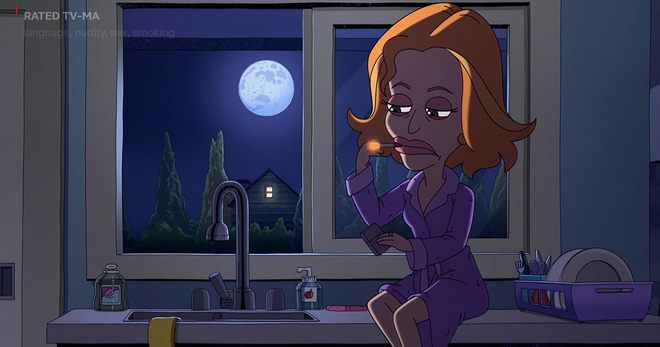Smoking and vaping in young people’s favorite shows isn’t just rampant, it’s often glamorized too
Shows most popular with young people frequently portray tobacco in a positive light – as glamorous, rebellious, and a status symbol – and even depict youth and teenagers using tobacco, according to Truth Initiative’s latest report on tobacco use on screens that finds pervasive smoking and vaping imagery continues to bombard young people and fuel the youth e-cigarette epidemic.
Truth Initiative’s fourth annual report looking at tobacco imagery in entertainment, “While You Were Streaming: Nicotine on Demand,” analyzed tobacco imagery across the 15 most popular streaming shows among 15- to 24-year-olds and found that 60% of their favorite new releases and 64% of the top binge-watched shows included tobacco depictions. These shows include “The Simpsons” (Fox), “Family Guy” (Fox), “Rick and Morty” (Adult Swim), “Big Mouth” (Netflix), and “Law & Order SVU” (NBC), “The Queen’s Gambit” (Netflix), “The Umbrella Academy” (Netflix), “Shameless” (Showtime), "On My Block” (Netflix), and more.
These frequent depictions put young people at risk. Smoking imagery on episodic programming can triple a young person’s odds of starting to vape, according to a landmark 2020 Truth Initiative study, adding to well-established research that shows exposure to smoking in movies causes young people to start using tobacco, a conclusion reached almost a decade ago in a 2012 Surgeon General report.
How tobacco use is portrayed on screen
Researchers found that out of 114 total streaming episodes with tobacco, only one could be classified as anti-smoking. Half were pro-smoking, meaning coders who reviewed the shows noted that tobacco was portrayed in ways that associated the products with themes like wealth, power, success, fun, harmlessness, rebellion, or glamor. The remainder of instances could not be categorized as positive or negative – for example, scenes of cigarette butts in an ash tray.
Not only are shows glamorizing tobacco use instead of portraying its risks and harms, many featured teens and youth using tobacco. Offending shows include “Family Guy,” “The Simpsons,” “Rick and Morty,” “Big Mouth,” and “Law & Order SVU.”
- In “The Simpsons,” 10-year-old Nelson Muntz smokes a pipe while strolling next to a playground with other children. Fox’s long-running animated hit continues to depict pervasive tobacco imagery, coming in second place with 95 tobacco depictions in its 2020 season.
- Netflix’s “Big Mouth,” an animated comedy that follows teens as they grapple with puberty, was among the top 10 most popular shows with young people and came in with the third highest number of tobacco depictions. In one scene, an older boyfriend pressures his teenage girlfriend into vaping.
- Fox’s “Family Guy,” the top tobacco offender among 2020 shows most popular with 15-24-year-olds, had 100 depictions of tobacco in its 18th season and was the second most popular show with young people overall. One episode features dad Peter Griffin offering his teenage daughter a cigarette, and another features a satirical ad for a local monster truck rally that offers people the chance to smoke inside.
- “The Queen’s Gambit” not only features its young lead chain-smoking cigarettes and includes tobacco in every episode, the show also appears to depict tobacco as something characters turn to when under stress. This characterization taps into a common misconception that nicotine is a stress-reliever, when in fact nicotine can worsen anxiety symptoms and intensify feelings of depression. (For more on the connection between nicotine and mental health, see the Truth Initiative report “Colliding Crises: Youth Mental Health and Nicotine Use.”)
Getting tobacco off screens
The entertainment industry should not be complicit with the tobacco industry in helping addict a new generation of young people to nicotine. Truth Initiative pushes for urgent action to address the issue, including:
- Calling on content creators to develop comprehensive anti-tobacco policies in a public domain.
- Continuing to deploy successful anti-tobacco and anti-vaping ads before and during shows that feature tobacco imagery.
- Certifying that the film industry accepted no tobacco industry payoffs in exchange for including tobacco depictions in a show.
- Providing tax and other incentives only to those productions that do not promote tobacco use.
- Expanding education, outreach, and research efforts to inform the public, parents, directors, writers, and producers about the importance of keeping tobacco out of shows.
More in tobacco in pop culture
Want support quitting? Join EX Program
By clicking JOIN, you agree to the Terms, Text Message Terms and Privacy Policy.
Msg&Data rates may apply; msgs are automated.



